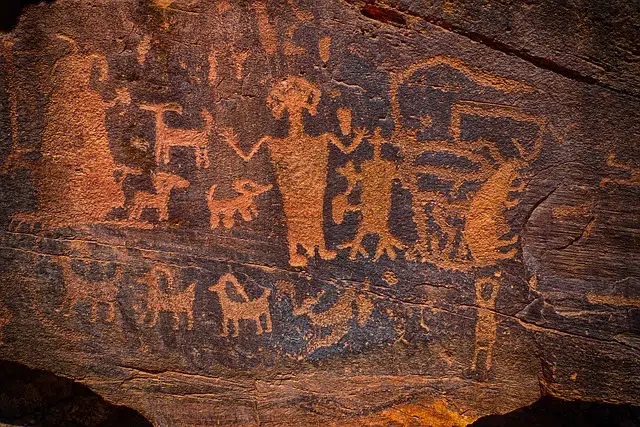
Prehistoric art used to be captured inside caves.
Art , from the Latin ars , is the nation that allows us to refer to the creations of human beings that express a sensitive vision of the imaginary or real world through the use of linguistic, plastic or sound resources.
Prehistoric is that belonging to or relating to the period that prehistory studies. This last term, for its part, is linked to human life existing before the development of writing (which emerged around the year 3,000 BC ).
Characteristics of prehistoric art
The concept of prehistoric art , therefore, refers to the artistic manifestations of primitive peoples . The expression is usually used to name very diverse historical periods and geographically distant creations, which means that prehistoric art contains very diverse works.
At a general level, it can be said that prehistoric art is characterized by schematism , symbolism and abstraction . These are expressions with ritual or mythical-religious purposes, unlike modern art, which aims at the aesthetic.
The cave painting
Cave painting is a manifestation of prehistoric art. These drawings were made on rocks or on the walls of caves. Some paintings are close to 40,000 years old and are still preserved because, being inside caves, they managed to withstand the passage of time.
Prehistoric art usually depicted hunting scenes or figures associated with deities. In addition to paintings, prehistoric sculptures can be mentioned, which in Europe were developed during the Paleolithic period . Bones, ivory plates, rocks and metals allowed these sculptures to be created.

The cave paintings constitute a testimony of prehistoric art.
Venus of Willendorf, jewel of prehistoric art
Among the most important works of prehistoric art is the Venus of Willendorf , a figurine of female forms that is associated with the group generally known as Paleolithic Venuses . This is a series of sculptures that share characteristics such as their exaggerated feminine attributes and size.
In the particular case of Willendorf, its height is approximately 11 centimeters, its face is covered and it does not have a base that allows it to stand. Its discovery took place in 1908 in a Paleolithic settlement on Austrian soil, during an excavation. It is estimated that it was created between 24,000 and 22,000 BC, and today it can be admired in the Natural History Museum of Vienna.
The importance of the Altamira cave
On the other hand, representing the cave painting is the shrunken bison from the Altamira cave, in Cantabria, Spain. The importance of this work is multiple, since it is located at the site where the first paintings of this nature were discovered, all belonging to the Upper Paleolithic and very well preserved.
When humans found the Altamira cave (for the second time) in 1879, scientists doubted the authenticity of the paintings, given that everything seemed to have been orchestrated. But once works with similar features were found in other caves, both within Spain and in France, truth prevailed over disbelief, and justice could be done to this impressive legacy. It is worth mentioning that the artistic value of the shrunken bison is comparable to that of the Sistine Chapel and its age is close to 15 thousand years.
Stonehenge, architecture and prehistoric art
Finally, Stonehenge is a monument whose immense popularity exceeds the limits of knowledge and interest in prehistoric art. Its diameter is just over 100 meters and it is estimated that it was built between the years 3100 and 1600 BC, a period that links the end of the Neolithic and the beginning of the Bronze Age.
Its importance is due to the fact that it raises a large number of questions regarding its origin, especially due to the sophistication of its architecture , which does not seem to have competition in its historical context.
